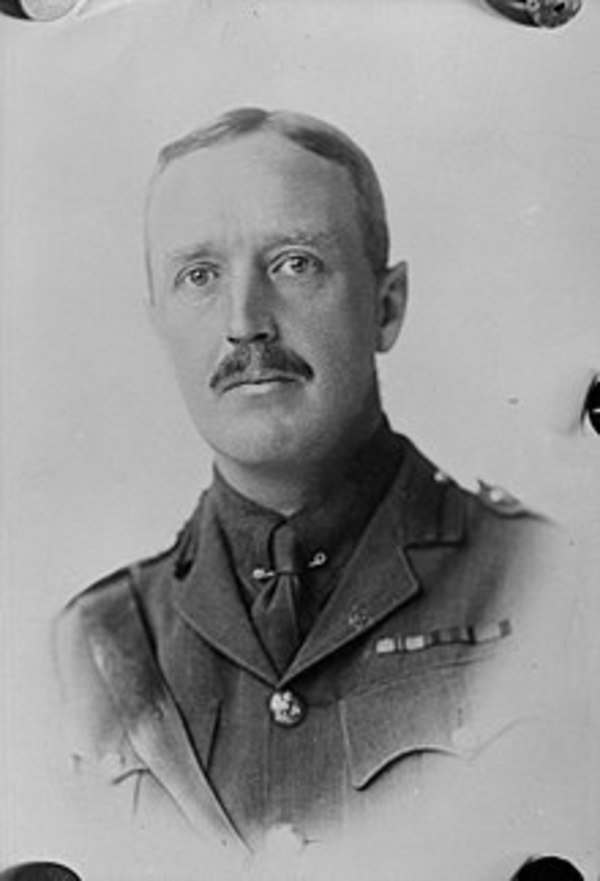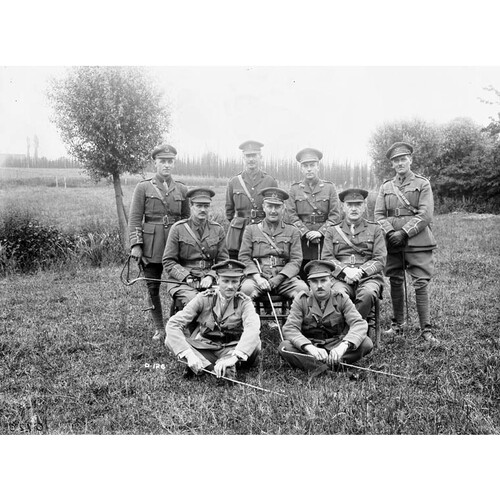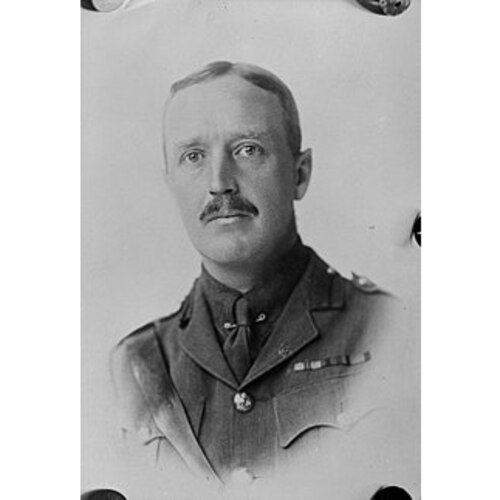
Source: Courtesy of Wikimedia Commons
LIPSETT, LOUIS JAMES, army officer; b. 14 June 1874 in Bundoran (Republic of Ireland), younger of the two sons of Richard Lipsett and Etty —; d. 14 Oct. 1918 near Saulzoir, France.
Louis James Lipsett was raised in Merthyr Tydfil, Wales, home of his mother’s family. When his mother was widowed in 1887, she took him to Bedford, England, for the good but inexpensive education at the local grammar school. A master, Dr James Edward Morris, recalled his literary ability and powers of expression and an accompanying failing, “He could not spell.” Despite the handicap, Lipsett was determined to make the army his career. By dint of much study and persistence, he passed the army entrance examination and was admitted into the Royal Military College at Sandhurst, England, in 1892, 35th out of 120 cadets. In later years, Morris claimed, “he always carried on him a pocket dictionary.”
After graduation from Sandhurst, Lipsett was commissioned a second lieutenant in the Royal Irish Regiment on 10 Oct. 1894, was promoted lieutenant in July 1897 while in India with his regiment’s 2nd Battalion, and saw active service during the Samana and Kurram valley operations in the 1897 campaign on the North-West Frontier of India and in the relief of Tirah (Pakistan) in 1897 and 1898. He narrowly missed dying of cholera. Fellow officers remembered him as a serious soldier, frugal enough to eke out his pay with the modest allowance his mother could afford, and yet “as jolly, unaffected and likeable as he had been as a boy at school.”
In February 1901 Lipsett achieved his captaincy. He studied French and German and qualified as a second-class interpreter in French. In 1903 he entered the Staff College at Camberley, England, placing second among the infantry candidates. His instructors included some of the better-known generals and staff officers of the approaching war. He earned a good report and a social reputation as one of the whips of the college drag-hunt. Lipsett’s first staff appointment was with the British army in southern Africa from March 1905 to the end of February 1907. He returned to England as an aide-de-camp to Major-General Theodore Edward Stephenson, his commander in southern Africa, who took over the 2nd Division at Aldershot. Next, for three years Lipsett served in his old regiment.
British staff officers were needed in Canada to help carry out the imperial military policy of standardization of training adopted in 1907 and 1909. On 27 July 1911 Lipsett took up the appointment of general staff officer, western Canada, with the local rank of major. According to Lieutenant-Colonel Archibald Cameron Macdonell* of Lord Strathcona’s Horse (Royal Canadians), one of the Canadian officers who knew him best, Lipsett’s qualities “made him, almost over night, a power for efficiency in our Western Militia world, from Port Arthur [Thunder Bay, Ont.] to Victoria.” His tact, sense of humour, and enthusiasm for sport made him popular. Unlike some British officers, a biographer noted, he seemed “determined to like the country and the people.” Certainly Lipsett was quick to appreciate the western Canadian spirit of independence and self-reliance, and willingness to improvise. In a succession of courses and special schools he helped train, influence, and inspire many of the officers who would lead the brigades and battalions of the Canadian Expeditionary Force, including Arthur William Currie*, Robert Gilmour Edwards Leckie, and William Frederick Hart-McHarg.
When war came in 1914, Lipsett’s first mission was to organize the defence of British Columbia, potentially menaced by the German East Asian Cruiser Squadron. He calmed fears, exaggerated the value of the two American-built submarines the premier, Sir Richard McBride, had purchased in Seattle, Wash., and made it unnecessary to keep a vast force under arms. Alone among the British officers in Canada, he was allowed command of a CEF battalion, the 8th, based on the 90th Regiment (Winnipeg Rifles). His officers found him a hard taskmaster who tolerated no slackness; his men reputedly adored him. A contemporary remembered him as “always accessible and charming in manner, yet there was that about him which made him respected and no one ever presumed on his kindness, except the few old soldiers, who with their war ribbons up, and uncanny intuition, never failed to touch a soft spot in his heart.”
Lipsett made the 8th one of the best battalions in Currie’s western 2nd Infantry Brigade. At the second battle for Ypres (Ieper), Belgium, his unit was the mainstay of the Canadian defence against the German assault on 24 April 1915, and Lipsett earned credit for ordering men to urinate on handkerchiefs and cotton bandoliers as a basis for a primitive protection against German chlorine gas. He was left in command of the brigade when Currie went back in a vain search for reinforcements. Lipsett rebuilt his shattered unit after the battle, succeeded to the 2nd Brigade in September when Currie was promoted to command the 1st Canadian Division, and in November planned and supervised the first large-scale raid on the German trenches.
Lipsett’s major step came in June 1916, after Major-General Malcolm Smith Mercer was killed in command of the 3rd Canadian Division at the outset of the German assault on Mount Sorrel, Belgium. In the final and successful Canadian counter-attack, Lipsett’s brigade was notably well handled. At the end of the battle, despite the directive of the minister of militia and defence, Sir Samuel Hughes*, to hand the 3rd Division to his son, Garnet Burk*, the corps commander, Lieutenant-General Sir Julian Hedworth George Byng*, gave it to Lipsett with promotion to the rank of major-general. A scratch formation badly mauled in its first serious battle, the 3rd Division could easily have become a problem. Instead Lipsett turned it into one of the two best divisions in the corps. He led it through the battle of the Somme in 1916, to success at Vimy Ridge, France, on 9 April 1917, to the toughest struggle of any Canadian division at Passchendaele (Passendale), Belgium, in October 1917, and to a shrewdly planned share of the victory at Amiens, France, on 8 Aug. 1918.
In a war in which generals had little personal influence, ordinary soldiers often remembered Lipsett. William Richard Bird*, no respecter of superiors, never forgot that Lipsett had appeared beside him at a lonely front-line sentry post. Ernest Davis recalled a derailment behind the lines. Lipsett’s staff car was the first that stopped: “This general got out of his car, organized everyone within reach into a rescue squad, all of us heaving at the derailed car, including the general himself. As I recall it too, his chauffeur gave visible evidence of hating to put his spotless shoulder to the load but he had to. . . . That one encounter told me that here was a general one could follow knowing he was not one of the remote kind, far above his men.”
Although a divisional commander could win few favours for his men, Lipsett got his troops the best of whatever was going, and it was no coincidence that the Dumbells, the best-known Canadian concert troupe of the war, came from his division and wore its badge. In return, Lipsett’s men trained hard and led the way in adopting the innovations in tactics and technology that transformed the costly failures of the Somme in 1916 into the costly victories of Amiens and Drocourt-Quéant in 1918.
An attack on 27 and 28 Aug. 1918 to clear the approaches to the Drocourt-Quéant line proved to be Lipsett’s last battle with the 3rd Division. The second senior divisional commander in the corps after Major-General David Watson*, he was the sole British officer among them. To ensure that only Canadians would hold senior positions, Currie, now corps commander, was content to see Lipsett go when the commander-in-chief, Sir Douglas Haig, asked for him to command the 4th British Infantry Division. Lipsett reluctantly took over the smaller formation on 14 Sept. 1918. A month later, on 14 Oct. 1918, as he crawled out from the Bois de Vordon near Saulzoir to get a better view of the ground his men would cross next day, a German machine-gun bullet hit him in the face. He managed to reach the wood, where he died. A day later, his body was buried at a military cemetery in Quéant. The 3rd Canadian Division organized the funeral. Lipsett’s old battalion provided the band and firing party and Currie led a strong contingent of Canadian mourners.
Lipsett was “arguably the best” of the Canadian divisional commanders, claimed historian Daniel George Dancocks, and probably the most popular with the men in the ranks. A contemporary biographer remembered him as “essentially a man of affairs, methodical and clear thinking.” He was a shrewd and thoughtful tactician whose pre-war professional dedication paid off under fire from Ypres to Amiens. His troops took pride that he shared their dangers when other generals led seemingly more sheltered lives. In turn, as his biographer commented, Lipsett understood the need “to set an example of fearlessness and disregard of danger to those under him at all times and in all places; in fact to lead and not to follow was the ideal which he set for himself and lived up to to the end.”
NA, RG 24, 2513, HQC 1522, pt.1. Private arch., Desmond Morton (Mississauga, Ont.), Canadian Expeditionary Force research files, Ernest Davis memoirs (photocopies), 33. PRO, WO 76/205: f.25; WO 95/148. W. R. Bird, Ghosts have warm hands (Toronto, 1968). D. G. Dancocks, Spearhead to victory: Canada and the Great War (Edmonton, 1987); Welcome to Flanders fields; the first Canadian battle of the Great War: Ypres, 1915 (Toronto, 1988). A. F. Duguid, Official history of the Canadian forces in the Great War, 1914–1919 (only 1v. in 2 pts. [1914–September 1915] was published, Ottawa, 1938), 1, pt.1: 269–362. H. G. Hart, The new annual army list . . . (London), 1903–11. A. M. J. Hyatt, General Sir Arthur Currie: a military biography (Toronto, 1987). “Major-General Louis James Lipsett, c.b., c.m.g.,” Canadian Defence Quarterly (Ottawa), 6 (1928–29): 293–300, and photo of Lipsett facing p.287. Desmond Morton, A peculiar kind of politics: Canada’s overseas ministry in the First World War (Toronto, 1982). Nicholson, CEF. Ousel (Bedford, Eng.), 27 Nov. 1918.
Cite This Article
Desmond Morton, “LIPSETT, LOUIS JAMES,” in Dictionary of Canadian Biography, vol. 14, University of Toronto/Université Laval, 2003–, accessed December 31, 2025, https://www.biographi.ca/en/bio/lipsett_louis_james_14E.html.
The citation above shows the format for footnotes and endnotes according to the Chicago manual of style (16th edition). Information to be used in other citation formats:
| Permalink: | https://www.biographi.ca/en/bio/lipsett_louis_james_14E.html |
| Author of Article: | Desmond Morton |
| Title of Article: | LIPSETT, LOUIS JAMES |
| Publication Name: | Dictionary of Canadian Biography, vol. 14 |
| Publisher: | University of Toronto/Université Laval |
| Year of publication: | 1998 |
| Year of revision: | 1998 |
| Access Date: | December 31, 2025 |





